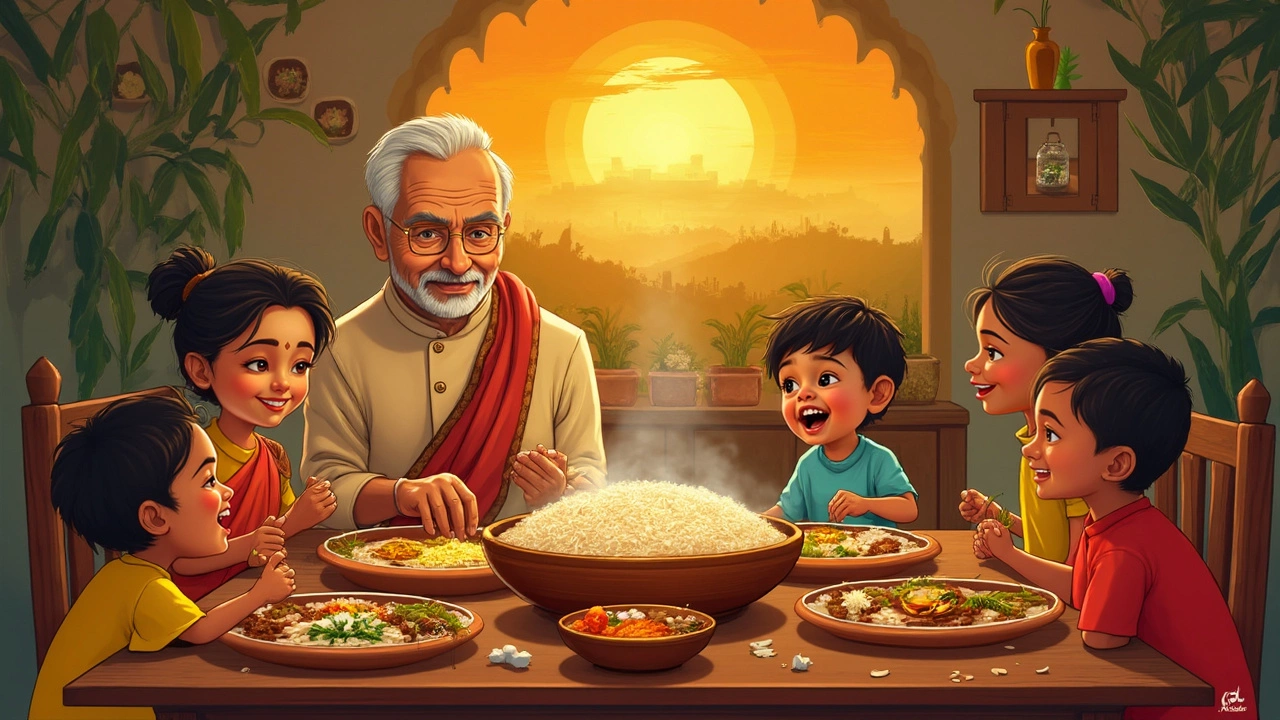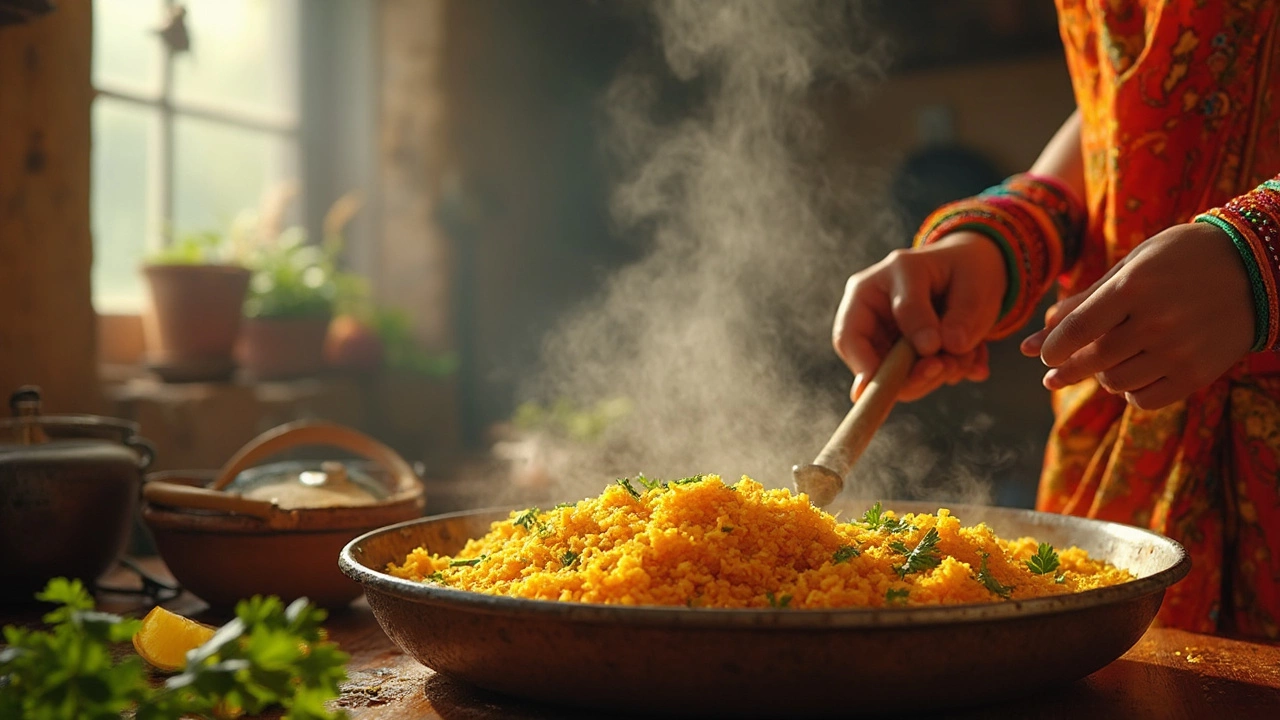Ever rushed through your morning, only to realize you haven't had a proper breakfast? We've all been there. In India, a go-to solution for this morning madness is Poha—a dish that's quick, easy, and hits the spot every time.
If you haven't met Poha yet, let me introduce you. Made from flattened rice, this dish is not just delicious but also packs a punch in nutritional value. Did you know it's rich in iron and low in calories? Perfect for those watching their diet while not wanting to compromise on taste.
With its roots mainly in Maharashtra but loved across the country, Poha becomes unique in each region. From adding peanuts, curry leaves, to a splash of lime, it's these little tweaks that keep the dish exciting and different every time.
- Introduction to Popular Indian Breakfasts
- The Rise of Poha: A Staple Choice
- Nutritional Benefits of Poha
- Regional Variations Across India
- Quick and Easy Poha Recipe
- Tips for the Perfect Morning Meal
Introduction to Popular Indian Breakfasts
In the bustling mornings of India, breakfast isn't just a meal—it's a ritual. From the North to the South, each region boasts its own must-try dishes that are not just filling but genuinely delightful.
Take a walk through the streets of India, and you'll encounter a colorful tapestry of flavors. Imagine biting into a crispy dosa in the South or diving into a spicy chole bhature in the North. These traditional breakfasts are more than just food; they reflect the rich cultural heritage and diversity of India.
Indian breakfast choices aren't just about taste. Many dishes, like the beloved idli, are steamed, making them both a healthy and a tasty start to the day. It's no wonder these foods have gained popularity beyond Indian borders too!
Let's not forget Poha. Often hailed as one of the fastest and tastiest breakfasts you can whip up, it remains a household favorite. The way it absorbs flavors yet retains its texture is almost magic.
Here's a quick look at why these breakfasts are so loved:
- Easy to prepare: Many can be whipped up in under 20 minutes.
- Nutritious: Often packed with proteins, vitamins, and minerals.
- Variety: Each dish offers a unique burst of flavor with regional spices.
Understanding these breakfasts is the key to grasping the essence of Indian mornings. Each dish comes with its own story, offering a taste of India’s rich and diverse culture right from your kitchen.
The Rise of Poha: A Staple Choice
When it comes to quick Indian breakfasts, Poha is like that little black dress—simple, versatile, and never fails you. Its popularity isn't just recent; it has a long-standing tradition in the heart of Indian homes, particularly in Maharashtra, where it holds a special place in the morning routine.
Poha's ascent to becoming a staple isn't by chance. The dish's adaptability is key. It's commonly paired with ingredients like potatoes, onions, peas, and a sprinkle of mustard seeds to create a mélange of flavors. The magic is in its simplicity—it’s just so easy to tweak to suit one's taste!
Why Poha Stands Out
No two Poha recipes are exactly the same, and that’s what keeps it interesting. In the north, it's sometimes served with a bit of curd or garnished with coriander, while down south, it might just get a touch of grated coconut. This adaptability is precisely why Poha continues to win hearts across cultures.
A fun fact? According to a recent survey, over 70% of Indian households report having Poha at least once a week. That's some breakfast loyalty!
"Poha holds the unique ability to bring families together every morning. It’s not just food; it’s tradition set on a plate,” remarks Chef Neeta Mehta, a well-known culinary expert.
Nutritional Goodness and Convenience
Beyond flavor, its health benefits contribute to its staple status. Poha is light on the stomach while being rich in carbohydrates, providing energy without the bloated feeling. Its high iron content is particularly beneficial, especially for kids and those looking to boost their mineral intake.
An easy-to-make dish, Poha can be prepared in just 15 minutes. Perfect for today’s hustle, right?
| Region | Main Ingredient Additions |
|---|---|
| Maharashtra | Peanuts, Coconut |
| North India | Coriander, Curd |
| South India | Grated Coconut, Curry Leaves |
With its roots set deeply in culture and taste, it's no wonder Poha has risen to be a breakfast choice that symbolizes both nourishment and nostalgia.
Nutritional Benefits of Poha
Why is Poha such a crowd favorite when it comes to Indian breakfast? It's not just about taste; it's also about the incredible nutritional profile that makes it a smart morning choice.
Low in Calories, High on Satisfaction
One of the great things about Poha is that it's naturally low in calories, making it ideal for anyone looking to enjoy their meal without overindulging. A typical serving of Poha contains around 250 calories, which fits right into a balanced diet plan.
Iron-Rich Goodness
For those who need an iron boost, Poha has got your back. Made from flattened rice, it retains a good amount of iron, helping tackle conditions like anemia. It's even been suggested to squeeze a little lemon over your Poha to enhance iron absorption in the body.
Gluten-Free and Easy to Digest
Flattened rice used in making Poha is naturally gluten-free, so it sits well with those who are sensitive to gluten. Plus, its light nature means it's easy on the digestive system, not leaving you in a sluggish post-breakfast slump.
Adaptable Nutrition
What's so versatile about Poha is that it can be packed with various veggies like peas, carrots, and onions, upping your fiber intake for the day. Want a protein kick? Toss in some peanuts or serve alongside a boiled egg.
| Nutrient | Amount (per 100g) |
|---|---|
| Calories | 110 kcal |
| Iron | 1.5 mg |
| Protein | 2.3 g |
| Dietary Fiber | 2.2 g |
Enhanced with Essential Vitamins
With the addition of items like mustard seeds and curry leaves, Poha provides essential vitamins such as Vitamin A and Vitamin C. A sprinkle of spices not only adds flavor but can improve your overall nutritional intake.
In short, Poha is more than a quick meal. It's a nutritious, wholesome choice that lets you enjoy a variety of flavors while keeping your health in check. So next time, when you're in need of a speedy, nutritious breakfast, you know where to look!

Regional Variations Across India
India's vastness isn't just about geography; it's about diversity in its food too. One dish that's been reimagined in numerous ways across the country is Poha. In Maharashtra, the Poha is often dressed with peanuts and a squeeze of lemon, making it slightly tangy and crunchy. Known locally as Kanda Poha, it's the go-to breakfast for many.
Down south in Karnataka, they have their version called Avalakki, which sometimes comes with a touch of sweetness thanks to jaggery. They like to mix it up with spices and grated coconut, creating a unique blend of flavors.
In the northern parts, like Madhya Pradesh, they have a love affair with Poha. It's served with a sprinkling of sev (a type of fried snack) on top, adding a delightful crunch to every bite. Bet you didn't think Poha could be dessert-like? Well, in Gujarat, people love to add a hint of sugar, making it slightly sweet and spicy at the same time.
Here's an interesting twist: in Bihar, Poha isn't complete without boiled potatoes and green peas tossed in. It's a hearty mix that fills you up pretty well.
The Recipe That Binds
Despite these regional twists, the core of Poha remains the same—flattened rice soaked and then spiced up with turmeric, green chilies, mustard seeds, and curry leaves. It's a prime example of how a simple base can be turned into something completely diverse yet equally delicious across different places.
There's something comforting about knowing that wherever you go in India, Poha will be there, waiting for you, with a little surprise packed within its grains. So, the next time you have it for breakfast, think about all the different kitchens across the country preparing it their own way.
Quick and Easy Poha Recipe
If you want to whip up a hearty Indian breakfast in no time, Poha is your best bet. It's the kind of meal that doesn't just fill you up but comforts you with its warmth and flavors. Ready to get started? Here's how.
Gather Your Ingredients
- 1 cup Flattened Rice (Poha)
- 1 medium Onion, finely chopped
- 1 small Potato, diced
- 2 green Chillies, finely chopped
- 1/4 cup Green Peas (optional)
- 1/4 tsp Turmeric Powder
- 1/2 tsp Mustard Seeds
- A pinch of Asafoetida (Hing)
- Salt to taste
- A handful of Curry Leaves
- 1 tbsp Oil
- Lemon wedges for garnish
- Fresh Coriander leaves for garnish
Step-by-Step Instructions
- Rinse the Poha: Start by washing the Poha under running water until it turns soft. Let it drain in a colander.
- Heat the Oil: In a pan, heat oil on medium flame. Add mustard seeds and let them splutter.
- Sauté the Veggies: Toss in the asafoetida, curry leaves, and green chillies, followed by onions. Sauté until the onions become translucent.
- Add Potatoes and Peas: Add diced potatoes and peas, cooking them until they are nearly done.
- Spice it Up: Mix in the turmeric powder and salt, allowing the mix to absorb the flavors.
- Combine with Poha: Now, fold in the rinsed Poha, stirring well to combine everything evenly.
- Final Touch: Cook for another 2-3 minutes, and finish with lemon juice and freshly chopped coriander.
Enjoy this Poha while it's warm and fresh. It's the ultimate savory delight to kickstart your day!
Tips for the Perfect Morning Meal
Starting your day with the right Indian breakfast can make all the difference. Poha, being your quick fix, can be elevated to something extraordinary with just a few small changes. Here are some tips to ensure it's just right every time.
1. Choose the Right Type of Poha
Not all flattened rice is created equal. Go for thick or medium poha, as it doesn't dissolve quickly and holds its shape well. This ensures a satisfying texture in each bite.
2. Rinse Smartly
Rinsing is key to getting the texture right. Give the poha a gentle wash under cold water and let it rest in the colander. Don’t overdo it; you’re just aiming to soften it, not turn it into mush.
3. Spice it Up
Here's where you can really personalize your poha. Use turmeric for color and health benefits, add green chilies for a kick, and don’t forget a dash of lime juice at the end. It brightens up the flavors!
“Cooking is all about blending the right flavors. A small splash of lemon can transform your poha from bland to grand.” - Chef Vikas Khanna
4. Add Crunch
Add roasted peanuts or a handful of sev on top. This will give your poha a delightful crunch, transforming it from a soft dish to something much more dynamic.
5. Pair with a Beverage
Nothing complements a hearty Poha better than a steaming cup of chai or a refreshing glass of buttermilk. The flavors contrast beautifully, making your meal balanced and satisfying.
6. Set the Right Ambiance
It might sound silly, but sitting down in a calm spot, maybe with some music or morning news in the background, can make your breakfast ritual more enjoyable.
These little tweaks can hopefully make Poha the breakfast you'll actually look forward to every morning. Give these tips a whirl, and you'll wonder how you ever had breakfast any other way!
